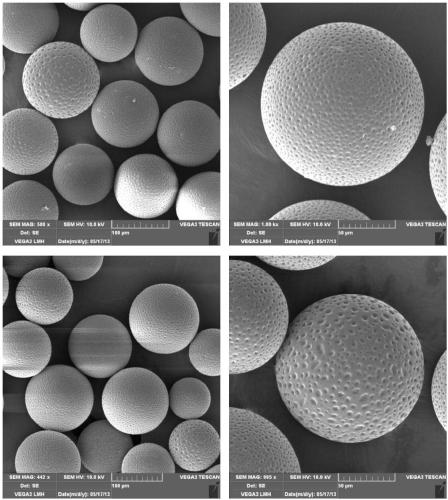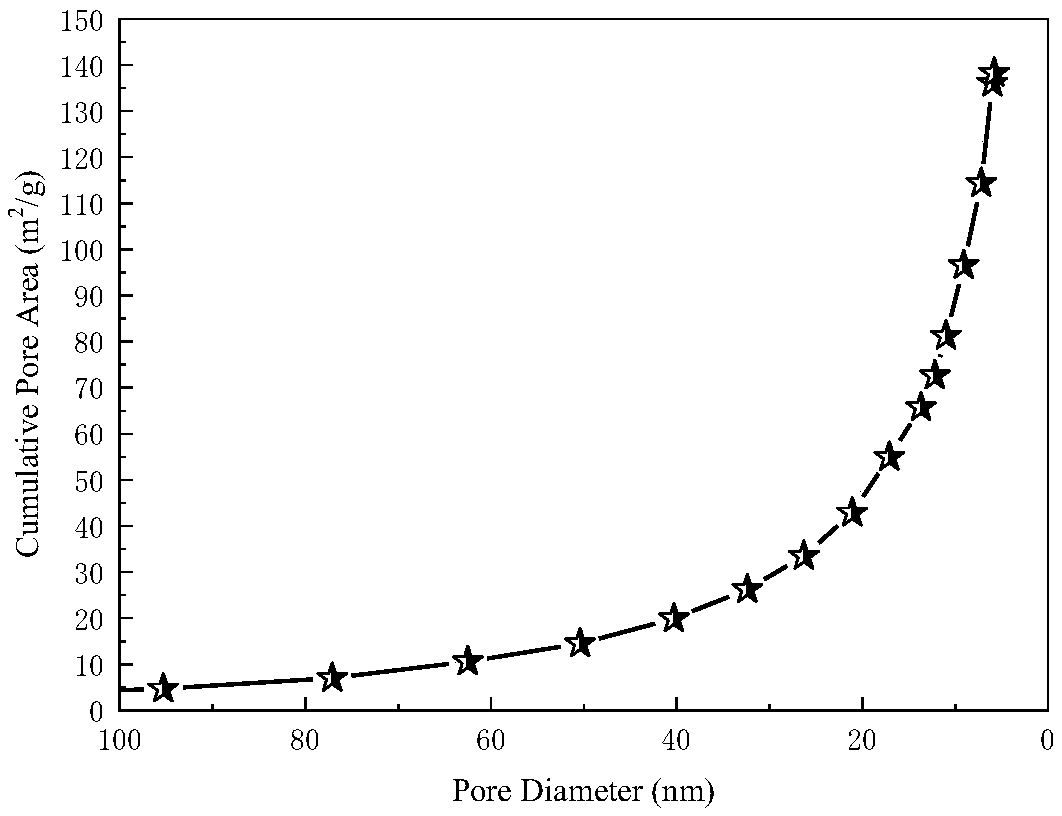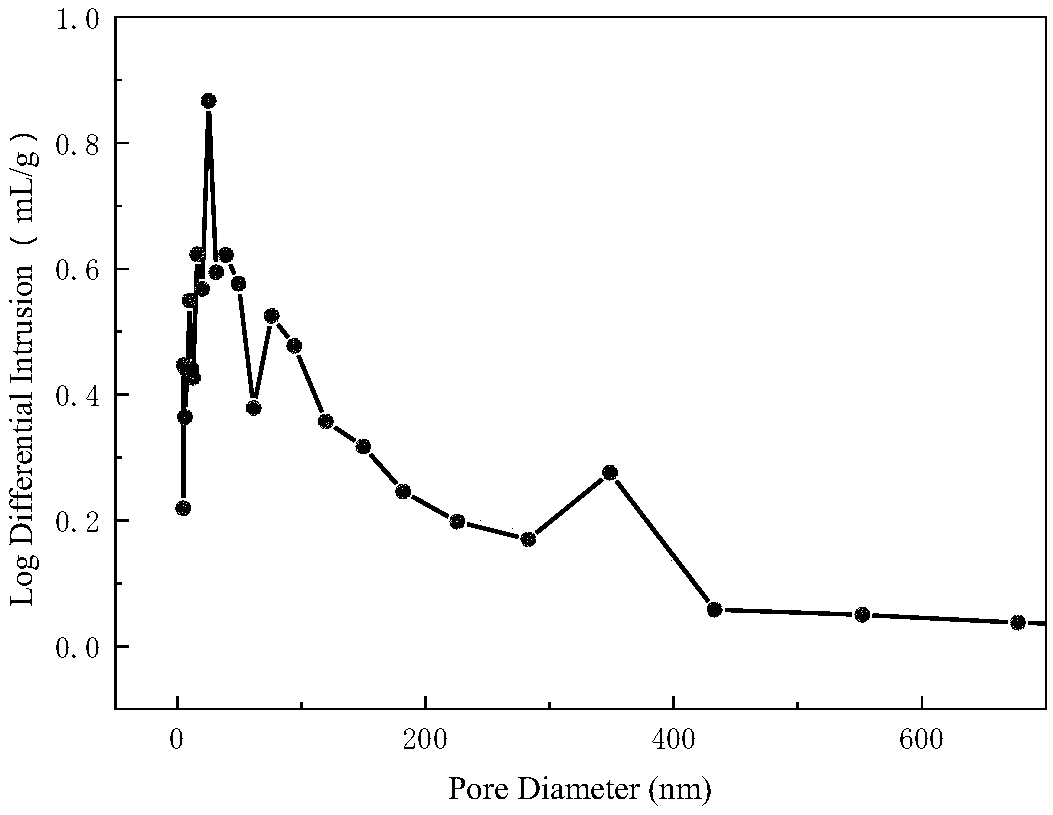Surface pinhole sunken porous resin sphere and preparation method
A porous resin and pinhole technology, applied in chemical instruments and methods, alkali metal oxides/hydroxides, inorganic chemistry, etc., can solve problems such as porous polymer microspheres that have not yet been seen, and achieve the convenience of large-scale production, Ease of mass transfer, high external area effect
- Summary
- Abstract
- Description
- Claims
- Application Information
AI Technical Summary
Problems solved by technology
Method used
Image
Examples
Embodiment 1
[0022] Example 1: Preparation of Surface Pinhole-like Depressed Porous Resin Balls
[0023] Take by weighing the aqueous solution 250g that is 1.75% gelatin, 0.2% polyvinyl alcohol (alcoholysis degree 80-88%, polymerization degree 1500-2000) and 0.5% sodium chloride that mass concentration is equipped with, add and be equipped with stirring and condensation In the three-necked bottle; weigh 0.70g of benzoyl peroxide, 7.00g of glycidyl methacrylate, 28.00g of styrene, 14.18g of ethylene glycol diacrylate, and 35.12g of toluene, fully dissolve and mix them into the three-necked bottle In the bottle, stand still for 5 minutes, start stirring at a stirring speed of 520rpm, after stirring for 30 minutes, raise the temperature of the system to 85°C, and react at a constant temperature for 6 hours; After treatment, the surface pinhole-shaped concave porous resin ball P (GMA-St-EGDA) can be obtained.
Embodiment 2
[0024] Example 2: Preparation of Surface Pinhole-like Depressed Porous Resin Balls
[0025] Take by weighing the aqueous solution 250g that is 1.75% gelatin, 0.2% polyvinyl alcohol (alcoholysis degree 80-88%, polymerization degree 1500-2000) and 0.5% sodium chloride that mass concentration is equipped with, add and be equipped with stirring and condensation In the three-necked bottle; weigh 0.76g of benzoyl peroxide, 7.60g of glycidyl methacrylate, 30.40g of styrene, 19.14g of ethylene glycol diacrylate, and 42.10g of toluene, fully dissolve, mix well and add to the three-necked bottle In the bottle, stand still for 5 minutes, start stirring at a stirring speed of 550rpm, after stirring for 30 minutes, raise the temperature of the system to 85°C, and react at a constant temperature for 6 hours; After treatment, the surface pinhole-shaped concave porous resin ball P (GMA-St-EGDA) can be obtained.
Embodiment 3
[0026] Example 3: Preparation of Surface Pinhole-like Depressed Porous Resin Balls
[0027] Take by weighing the aqueous solution 250g that is 1.75% gelatin, 0.2% polyvinyl alcohol (alcoholysis degree 80-88%, polymerization degree 1500-2000) and 0.5% sodium chloride that mass concentration is equipped with, add and be equipped with stirring and condensation In the three-necked bottle; weigh 1.00g of benzoyl peroxide, 10.00g of glycidyl methacrylate, 40.00g of styrene, 20.00g of ethylene glycol diacrylate, and 54.00g of toluene, fully dissolve and mix them into the three-necked bottle In the bottle, stand still for 5 minutes, start stirring at a stirring speed of 500 rpm, after stirring for 30 minutes, raise the temperature of the system to 85°C, and react at a constant temperature for 6 hours; After treatment, the surface pinhole-shaped concave porous resin ball P (GMA-St-EGDA) can be obtained.
PUM
| Property | Measurement | Unit |
|---|---|---|
| alcoholysis degree | aaaaa | aaaaa |
| degree of polymerization | aaaaa | aaaaa |
Abstract
Description
Claims
Application Information
 Login to View More
Login to View More - Generate Ideas
- Intellectual Property
- Life Sciences
- Materials
- Tech Scout
- Unparalleled Data Quality
- Higher Quality Content
- 60% Fewer Hallucinations
Browse by: Latest US Patents, China's latest patents, Technical Efficacy Thesaurus, Application Domain, Technology Topic, Popular Technical Reports.
© 2025 PatSnap. All rights reserved.Legal|Privacy policy|Modern Slavery Act Transparency Statement|Sitemap|About US| Contact US: help@patsnap.com



